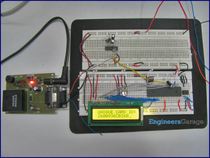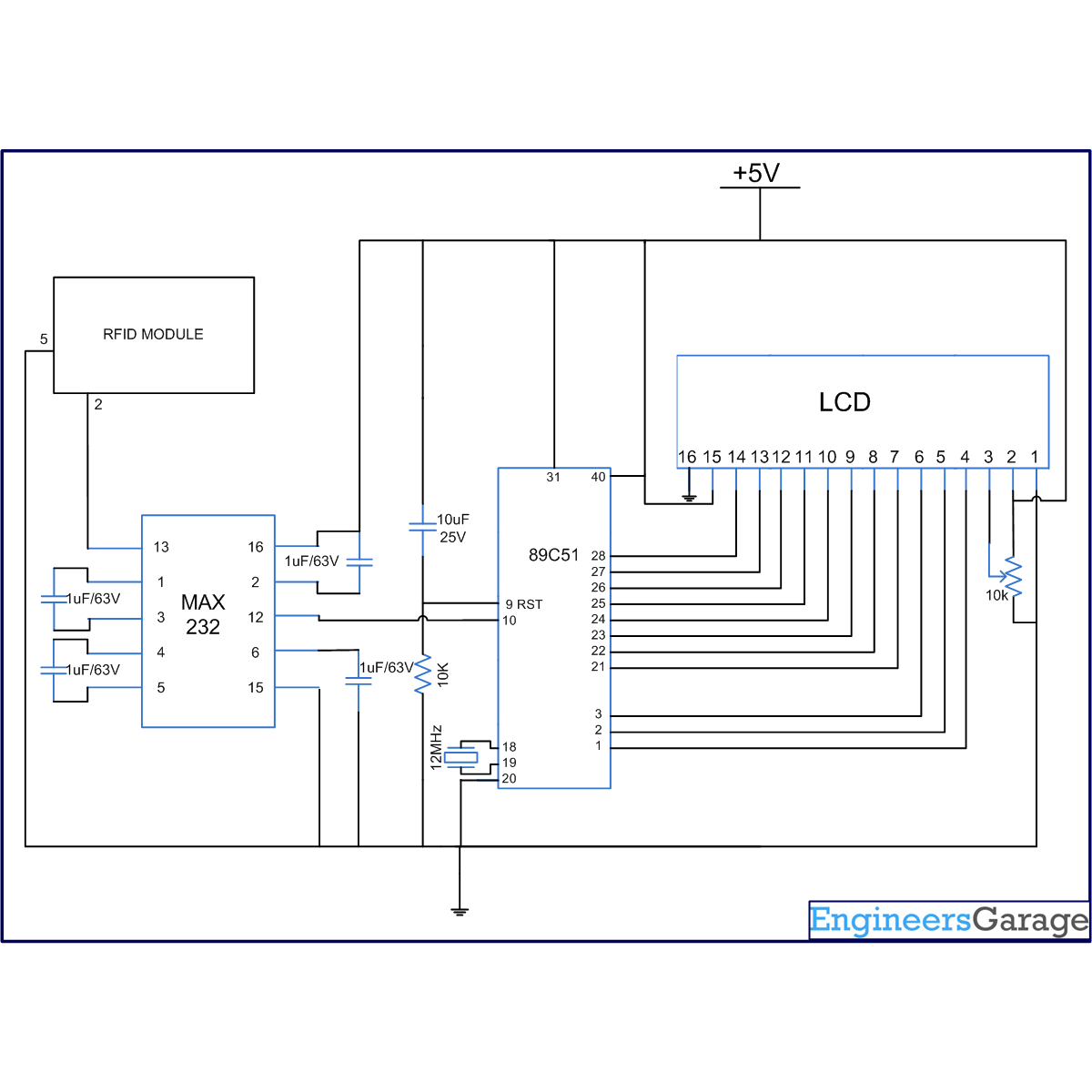An RFID (Radio-frequency identification and detection) reader is a device which is used to communicate with RFID tags by receiving and transmitting signals. These signals use radio waves for wireless communication.RFID tag is applied to products, individuals or animals to identify and track them. The identification is done through a unique serial number. This topic covers the interfacing of a passive RFID system with AT89C51. The code of RFID tag is also displayed on an LCD interface. The free source code for the program is avaiable in C.
An RFID (Radio-frequency identification and detection) reader is a device which is used to communicate with RFID tags by receiving and transmitting signals.  These signals use radio waves for wireless communication. RFID tag is applied to products, individuals or animals to identify and track them. The identification is done through a unique serial number. This topic covers the interfacing of a passive RFID system with AT89C51. The code of RFID tag is also displayed on an LCD interface. The free source code for the program is available in C. An RFID module basically consists of two parts, namely, a tag and a reader. A typical RFID system consists of an antenna, a transceiver and a transponder (RF tag). The radio frequency is read by the transceiver and the information is transferred to a device for further processing. The information (the unique serial number) to be transmitted is stored in the RF tag or transponder. The transponder contains a chip and an antenna mounted on a substrate. The chip transmits the relevant information through antenna.
These signals use radio waves for wireless communication. RFID tag is applied to products, individuals or animals to identify and track them. The identification is done through a unique serial number. This topic covers the interfacing of a passive RFID system with AT89C51. The code of RFID tag is also displayed on an LCD interface. The free source code for the program is available in C. An RFID module basically consists of two parts, namely, a tag and a reader. A typical RFID system consists of an antenna, a transceiver and a transponder (RF tag). The radio frequency is read by the transceiver and the information is transferred to a device for further processing. The information (the unique serial number) to be transmitted is stored in the RF tag or transponder. The transponder contains a chip and an antenna mounted on a substrate. The chip transmits the relevant information through antenna.
An RFID module basically consists of two parts, namely, a tag and a reader. A typical RFID system consists of an antenna, a transceiver and a transponder (RF tag). The radio frequency is read by the transceiver and the information is transferred to a device for further processing. The information (the unique serial number) to be transmitted is stored in the RF tag or transponder.
The transponder contains a chip and an antenna mounted on a substrate. The chip transmits the relevant information through antenna. The antenna also receives the electromagnetic waves sent by the RFID reader.
Different RFID tags work on different frequencies. Here low frequency, 125 kHz, RFID tags have been used. These tags work within a range of 10 cm. When an RFID tag comes in this range, the reader detects it and sends a unique code of the tag serially. This serial code, consisting of 12 bytes, is received by the microcontroller.
|
RFID Reader
|
MAX232
|
AT89C51
|
|
|
Rx
|
R1 IN
|
R1 OUT
|
Rx
|
Pins 1-3 of port P1 (P1.0, P1.1 & P1.2 respectively) of AT89C51 are connected to the control pins 4-6 LCD. The unique identification code of RFID tag is displayed on the LCD.
In the program, Timer1 is configured for serial communication. The baud rate is set to 9600bps for data transmission. The LCD is initialized to display the code. When a card/tag comes in the proximity of RFID reader, the microcontroller reads the code and sends it to the LCD module.
Project Source Code
###
//Program to interface RFID with 8051 microcontroller (AT89C51) #include<reg51.h> unsigned int data_out,command=0x80,temp; sfr lcd_data_pin=0xA0; //P2 port sbit rs=P1^0; //Register select sbit rw=P1^1; //Read/Write sbit en=P1^2; //Enable pin unsigned char card_id[12]; void delay(unsigned int count) //Function to provide delay { int i,j; for(i=0;i<count;i++) for(j=0;j<1275;j++); } void lcd_command(unsigned char comm) //Lcd command funtion { lcd_data_pin=comm; en=1; rs=0; rw=0; delay(1); en=0; } void lcd_data(unsigned char disp) //Lcd data function { lcd_data_pin=disp; en=1; rs=1; rw=0; delay(1); en=0; } lcd_string(unsigned char *disp) //Function to send string { int x; for(x=0;disp[x]!=0;x++) { lcd_data(disp[x]); } } void lcd_ini() //Function to initialize the LCD { lcd_command(0x38); delay(5); lcd_command(0x0F); delay(5); lcd_command(0x80); delay(5); } void recieve() //Function to recieve data serialy from RS232 { unsigned char k; for(k=0;k<12;k++) { while(RI==0); card_id[k]=SBUF; RI=0; } } void main() { int l; TMOD=0x20; //Enable Timer 1 TH1=0XFD; SCON=0x50; TR1=1; // Triggering Timer 1 lcd_ini(); lcd_command(0x81); //Place cursor to second position of first line lcd_string("UNIQUE CARD ID:"); delay(200); while(1) { recieve(); lcd_command(0xC1); //Place cursor to second position of second line for(l=0;l<12;l++) { lcd_data(card_id[l]); } } }###
Circuit Diagrams
Project Components
Project Video
Filed Under: 8051 Microcontroller.
Filed Under: 8051 Microcontroller.



Questions related to this article?
👉Ask and discuss on Electro-Tech-Online.com and EDAboard.com forums.
Tell Us What You Think!!
You must be logged in to post a comment.